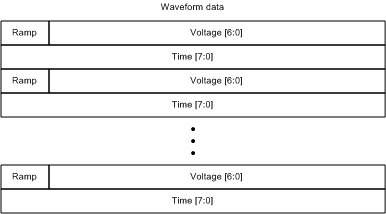ZHCSE01C December 2012 – March 2018 DRV2604
PRODUCTION DATA.
- 1 特性
- 2 应用
- 3 说明
- 4 修订历史记录
- 5 Pin Configuration and Functions
- 6 Specifications
-
7 Detailed Description
- 7.1 Overview
- 7.2 Functional Block Diagram
- 7.3
Feature Description
- 7.3.1 Support for ERM and LRA Actuators
- 7.3.2 Smart-Loop Architecture
- 7.3.3 Open-Loop Operation for LRA
- 7.3.4 Open-Loop Operation for ERM
- 7.3.5 Flexible Front-End Interface
- 7.3.6 Edge Rate Control
- 7.3.7 Constant Vibration Strength
- 7.3.8 Battery Voltage Reporting
- 7.3.9 One-Time Programmable (OTP) Memory for Configuration
- 7.3.10 Low-Power Standby
- 7.3.11 Device Protection
- 7.4 Device Functional Modes
- 7.5
Programming
- 7.5.1 Auto-Resonance Engine Programming for the LRA
- 7.5.2 Automatic-Level Calibration Programming
- 7.5.3 I2C Interface
- 7.5.4 Programming for Open-Loop Operation
- 7.5.5 Programming for Closed-Loop Operation
- 7.5.6 Auto Calibration Procedure
- 7.5.7 Programming On-Chip OTP Memory
- 7.5.8 Waveform Playback Programming
- 7.6
Register Map
- 7.6.1 Status (Address: 0x00)
- 7.6.2 Mode (Address: 0x01)
- 7.6.3 Real-Time Playback Input (Address: 0x02)
- 7.6.4 HI_Z (Address: 0x03)
- 7.6.5 Waveform Sequencer (Address: 0x04 to 0x0B)
- 7.6.6 GO (Address: 0x0C)
- 7.6.7 Overdrive Time Offset (Address: 0x0D)
- 7.6.8 Sustain Time Offset, Positive (Address: 0x0E)
- 7.6.9 Sustain Time Offset, Negative (Address: 0x0F)
- 7.6.10 Brake Time Offset (Address: 0x10)
- 7.6.11 Rated Voltage (Address: 0x16)
- 7.6.12 Overdrive Clamp Voltage (Address: 0x17)
- 7.6.13 Auto-Calibration Compensation Result (Address: 0x18)
- 7.6.14 Auto-Calibration Back-EMF Result (Address: 0x19)
- 7.6.15 Feedback Control (Address: 0x1A)
- 7.6.16 Control1 (Address: 0x1B)
- 7.6.17 Control2 (Address: 0x1C)
- 7.6.18 Control3 (Address: 0x1D)
- 7.6.19 Control4 (Address: 0x1E)
- 7.6.20 V(BAT) Voltage Monitor (Address: 0x21)
- 7.6.21 LRA Resonance Period (Address: 0x22)
- 7.6.22 RAM-Address Upper Byte (Address: 0xFD)
- 7.6.23 RAM-Address Lower Byte (Address: 0xFE)
- 7.6.24 RAM Data Byte (Address: 0xFF)
- 8 Application and Implementation
- 9 Power Supply Recommendations
- 10Layout
- 11器件和文档支持
- 12机械、封装和可订购信息
7.5.8.2.4.2 RAM Waveform Data Format
The library data contents can take two forms which are voltage-time pair and linear ramp. The voltage-time pair method implements a set and wait protocol, which is an efficient method of actuator control for most types of waveforms. This method becomes inefficient when ramping waveforms is desired, therefore a linear ramp method is also supported which linearly interpolates a set of voltages between two amplitude values. Both methods require only two bytes of data per set point. The linear ramp method uses a minimum of four bytes so that linear interpolation can be done to the next set point. The most significant bit of the voltage value is reserved to indicate the linear ramping mode.
 Figure 29. Waveform Data Structure
Figure 29. Waveform Data Structure
Data is stored as interleaved voltage-time pairs. Voltage in the voltage-time pair is a 7-bit signed number with range –63 to 63 when in bidirectional mode (BIDIR_INPUT = 1), and a 7-bit unsigned number with a range of 0 to 127 when in unidirectional mode (BIDIR_INPUT = 0). The MSB of the voltage byte is reserved for the linear ramping mode.
The Time value is the number of ticks that the Voltage will last. the absolute time is number of ticks × 5 ms.
When the most significant bit of the Voltage is high, the engine interprets a linear interpolation between that voltage and the following voltage point. The following voltage point can either be a part of a regular voltage-time pair, or a subsequent ramp. The following lists the sequence of bytes:
- Byte1 — Voltage1 (MSB High)
- Byte2 — Time1
- Byte3 — Voltage2
- Byte4 — Time2
The engine creates a linear interpolation between Voltage1 and Voltage2 over the time period Time1, where Time1 is a number of 5-ms ticks. The start value for the ramp is the 7-bit value contained in Voltage1. The end amplitude is the 7-bit value contained in Voltage2. The MSB in Voltage2 can indicate a following voltage-time pair or the starting point in a subsequent ramp.